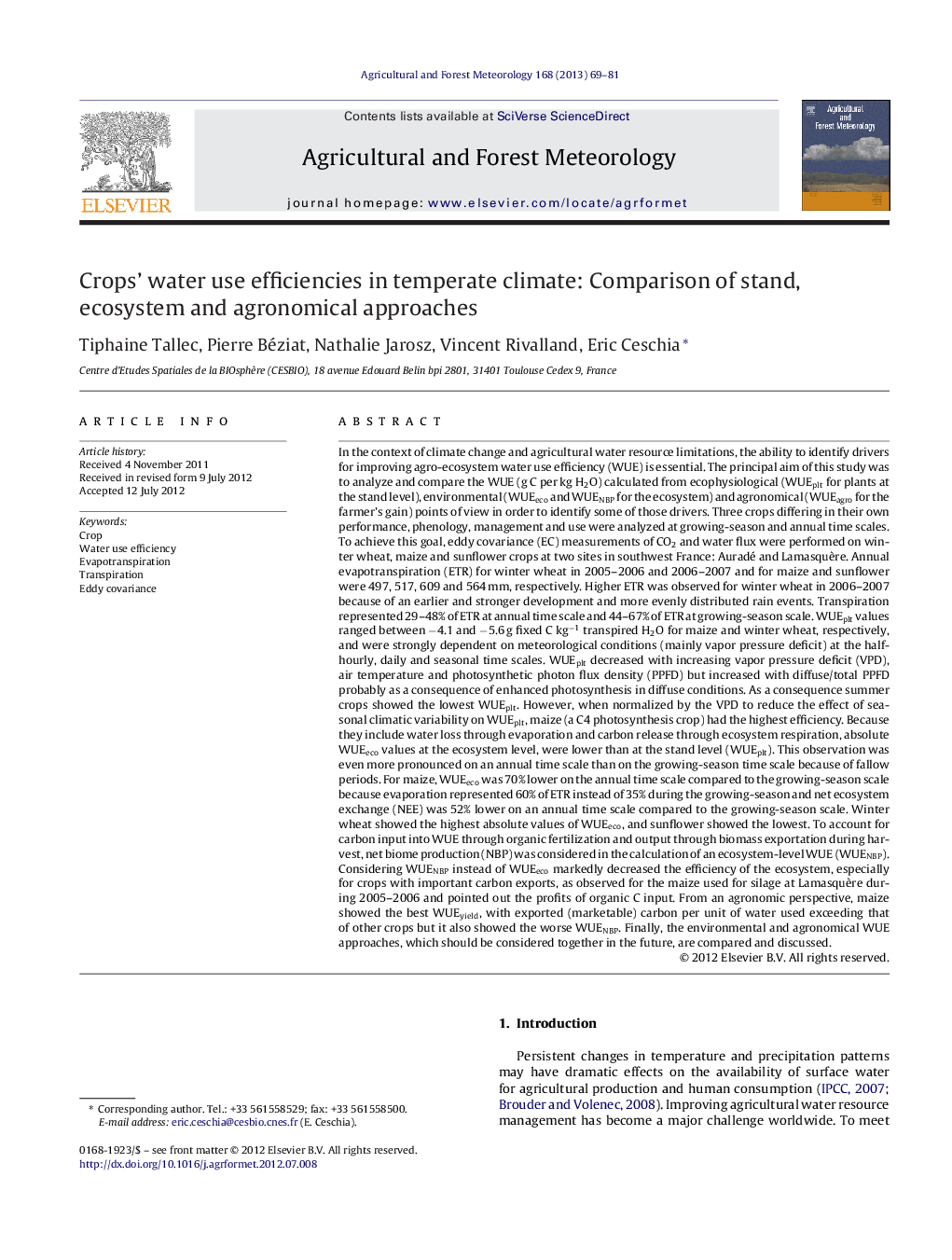| کد مقاله | کد نشریه | سال انتشار | مقاله انگلیسی | نسخه تمام متن |
|---|---|---|---|---|
| 81930 | 158362 | 2013 | 13 صفحه PDF | دانلود رایگان |

In the context of climate change and agricultural water resource limitations, the ability to identify drivers for improving agro-ecosystem water use efficiency (WUE) is essential. The principal aim of this study was to analyze and compare the WUE (g C per kg H2O) calculated from ecophysiological (WUEplt for plants at the stand level), environmental (WUEeco and WUENBP for the ecosystem) and agronomical (WUEagro for the farmer's gain) points of view in order to identify some of those drivers. Three crops differing in their own performance, phenology, management and use were analyzed at growing-season and annual time scales. To achieve this goal, eddy covariance (EC) measurements of CO2 and water flux were performed on winter wheat, maize and sunflower crops at two sites in southwest France: Auradé and Lamasquère. Annual evapotranspiration (ETR) for winter wheat in 2005–2006 and 2006–2007 and for maize and sunflower were 497, 517, 609 and 564 mm, respectively. Higher ETR was observed for winter wheat in 2006–2007 because of an earlier and stronger development and more evenly distributed rain events. Transpiration represented 29–48% of ETR at annual time scale and 44–67% of ETR at growing-season scale. WUEplt values ranged between −4.1 and −5.6 g fixed C kg−1 transpired H2O for maize and winter wheat, respectively, and were strongly dependent on meteorological conditions (mainly vapor pressure deficit) at the half-hourly, daily and seasonal time scales. WUEplt decreased with increasing vapor pressure deficit (VPD), air temperature and photosynthetic photon flux density (PPFD) but increased with diffuse/total PPFD probably as a consequence of enhanced photosynthesis in diffuse conditions. As a consequence summer crops showed the lowest WUEplt. However, when normalized by the VPD to reduce the effect of seasonal climatic variability on WUEplt, maize (a C4 photosynthesis crop) had the highest efficiency. Because they include water loss through evaporation and carbon release through ecosystem respiration, absolute WUEeco values at the ecosystem level, were lower than at the stand level (WUEplt). This observation was even more pronounced on an annual time scale than on the growing-season time scale because of fallow periods. For maize, WUEeco was 70% lower on the annual time scale compared to the growing-season scale because evaporation represented 60% of ETR instead of 35% during the growing-season and net ecosystem exchange (NEE) was 52% lower on an annual time scale compared to the growing-season scale. Winter wheat showed the highest absolute values of WUEeco, and sunflower showed the lowest. To account for carbon input into WUE through organic fertilization and output through biomass exportation during harvest, net biome production (NBP) was considered in the calculation of an ecosystem-level WUE (WUENBP). Considering WUENBP instead of WUEeco markedly decreased the efficiency of the ecosystem, especially for crops with important carbon exports, as observed for the maize used for silage at Lamasquère during 2005–2006 and pointed out the profits of organic C input. From an agronomic perspective, maize showed the best WUEyield, with exported (marketable) carbon per unit of water used exceeding that of other crops but it also showed the worse WUENBP. Finally, the environmental and agronomical WUE approaches, which should be considered together in the future, are compared and discussed.
► Examination of WUEs from ecophysiological, environmental and agronomical points of view, according to crop species, management and climate.
► WUEs depend on plant species characteristics, carbon input/exportation and fallow periods.
► Agronomical WUE (yield/ETR) classifies maize for silaging as the most efficient (2.5 and 7.5 times higher than winter wheat and sunflower).
► Environmental WUE (NBP/ETR) classifies winter wheat as the best one (only crop fixing carbon when loosing water).
Journal: Agricultural and Forest Meteorology - Volume 168, 15 January 2013, Pages 69–81